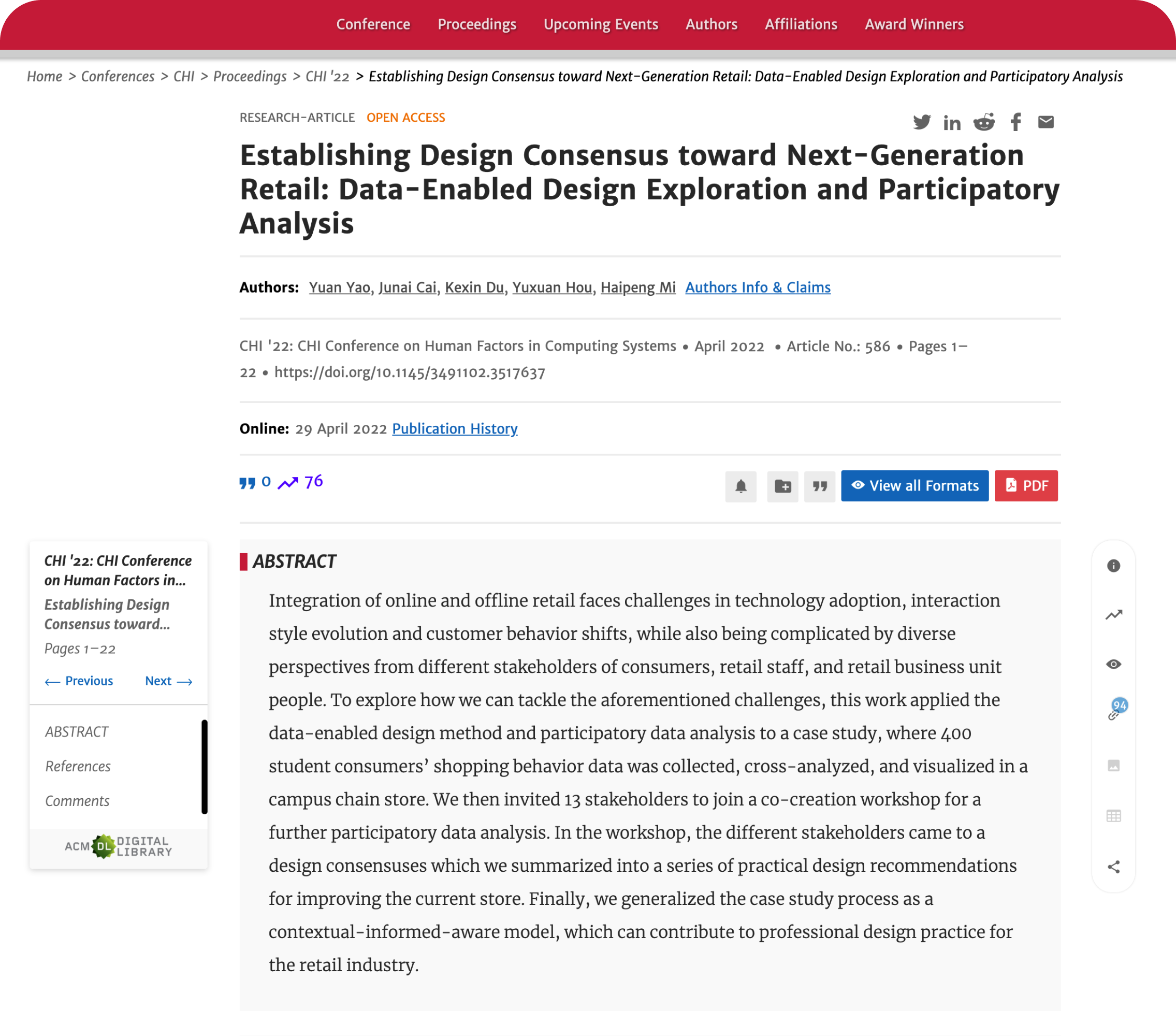
Establishing Design Consensus toward Next-Generation Retail
Research Project
MY ROLES
UX Researcher
UX Designer
TOOLS
Keynote
Miro
MindNote
ADVISOR
Yuan Yao
Haipeng Mi
TIMELINE
3 months
TAGS
Data-Enabled Design
Workshop
Participatory Analysis
DESCRIPTATION
I analyzed 275 customer surveys to extract insights and define design strategies, then co-led a participatory workshop with 13 stakeholders. I initialed a Vision Value Map to align their perspectives, revealing shared goals around product diversity, intelligence, convenience, and efficiency.
CONTEXT
As part of a data-enabled retail study with 400 student consumers, I co-led the stakeholder analysis and participatory process to bridge customers, staff, and business units—turning behavioral data into actionable design recommendations.
RESULT | PUBLISHED AT 2022 ACM CHI CONFERENCES
I stepped in after the customer study with a mandate: turn raw inputs into shared direction. Practically, that meant three jobs—make sense of the 275 survey responses, translate them into testable strategies, and design a participatory workshop to validate what matters.

WORK PROCESS
01. MISSIONS
After collecting and analyzing customer data (275 valid survey responses and behavioral patterns from 400 shoppers), I moved into the stakeholder phase to transform quantitative findings into shared insights through participatory analysis.
02. WORKSHOP SETUP AND DATA SHARING
The session began with an introduction to data-enabled design and retail innovation examples, inspiring participants to think beyond existing store models.Then, I presented data visualizations and insights from the previous study (shopping paths, purchase rates, gender behavior differences) to help stakeholders interpret real behavioral evidence.

03. TWO-STAGES DISCUSSIONS
Round 1: Grouped Discussions
Participants were divided by role (customers, staff, business unit). Each group reviewed the data and shared reactions from their own perspectives. This helped surface mismatched assumptions — for example, how shelf layouts designed for efficiency often harmed the shopping experience.
Participants were divided by role (customers, staff, business unit). Each group reviewed the data and shared reactions from their own perspectives. This helped surface mismatched assumptions — for example, how shelf layouts designed for efficiency often harmed the shopping experience.
Round 2: Mixed Groups
Participants were divided by role (customers, staff, business unit). Each group reviewed the data and shared reactions from their own perspectives. This helped surface mismatched assumptions — for example, how shelf layouts designed for efficiency often harmed the shopping experience.
Participants were divided by role (customers, staff, business unit). Each group reviewed the data and shared reactions from their own perspectives. This helped surface mismatched assumptions — for example, how shelf layouts designed for efficiency often harmed the shopping experience.

04. PARTICIPATORY ANALYSIS - Vision Value Map
I guided participants through creating a Vision Value Map using affinity diagramming.
This helped visualize what each group valued in their “dream store,” revealing four consistent categories aligned with earlier data analysis: Space, Commodity, Interaction, and Management.
This helped visualize what each group valued in their “dream store,” revealing four consistent categories aligned with earlier data analysis: Space, Commodity, Interaction, and Management.
Key findings included:
- Demand for more product variety and clearer pricing.
- Interest in combining online and offline experiences for smoother interactions.
- Emphasis on automation and intelligent systems for management.
- Desire for comfortable, socially engaging spaces where customers can interact naturally.
- Demand for more product variety and clearer pricing.
- Interest in combining online and offline experiences for smoother interactions.
- Emphasis on automation and intelligent systems for management.
- Desire for comfortable, socially engaging spaces where customers can interact naturally.
Despite different focuses, all stakeholders shared a common vision: a future store centered on diversity, intelligence, convenience, and efficiency.

Vision Value Map: The closer to the central target, the advices are more important.
05. DESIGN RECOMMENDATIONS
The workshop results were translated into nine actionable design directions, summarized under four themes:
- Space Design
Redesign shopping paths, balance crowded zones, add gender-sensitive and social areas. - Commodity Selection
Integrate online trends into offline shelves and create seasonal or event-based product zones. - Interaction Experience
Simplify digital interactions, enhance privacy, and personalize recommendations without burdening users. - Management Function
Develop a visualized system for staff task management, restocking, and scheduling.
06. DESIGN MODEL DEVELOPMENT
Finally, the team distilled the entire process into the Contextual–Informed–Aware Model, representing how data evolves into consensus:
- Contextual: Collect and visualize customer data.
- Informed: Engage stakeholders to interpret data collaboratively.
- Aware: Reflect and translate insights into sustainable, human-centered design strategies.

